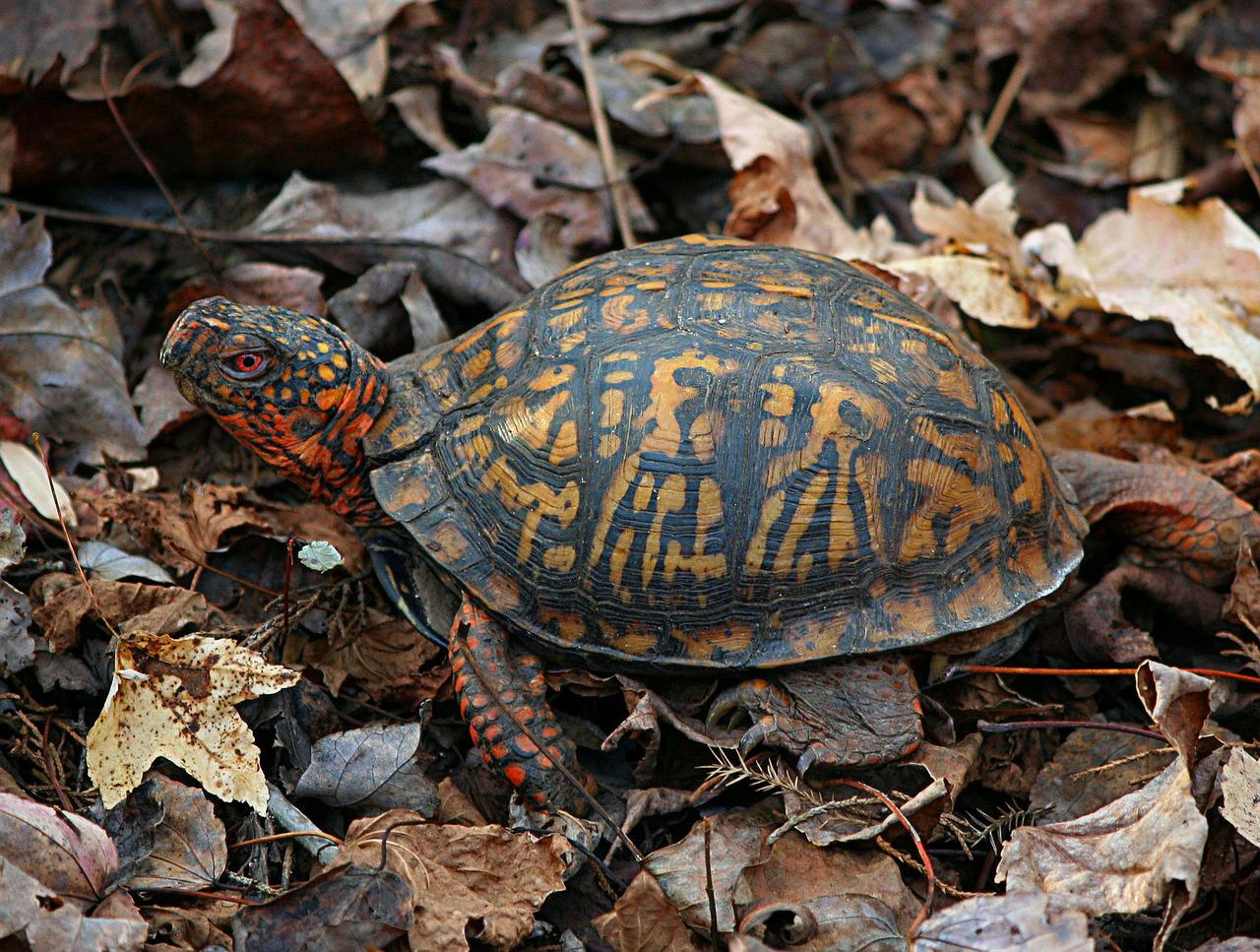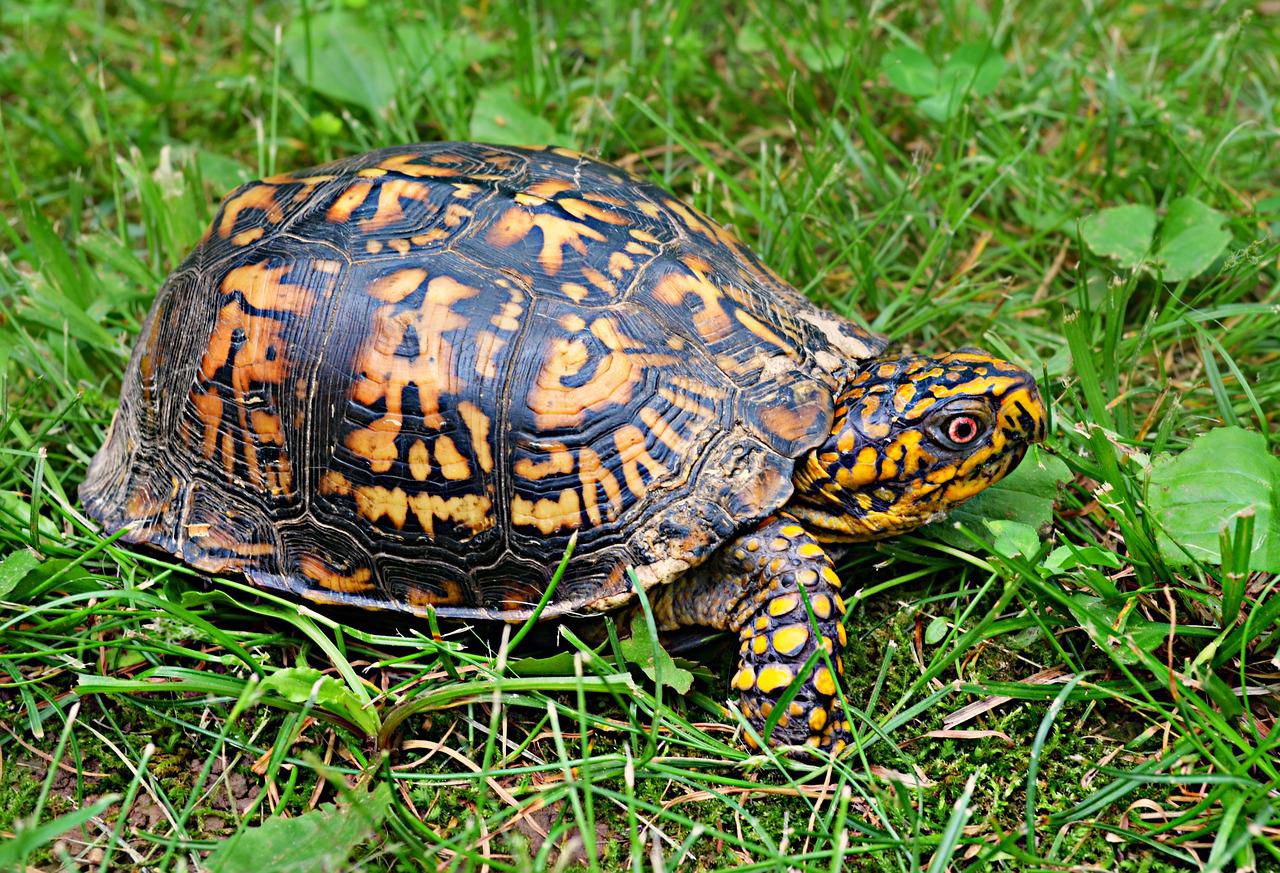Are you interested in learning how to properly care for your newborn box turtle? You no longer need to be concerned about providing proper care for young box turtles because we have compiled a guide that explains everything you need to be aware of in this regard.
In this article, you will learn How to Take care of a Baby Box Turtle.
Box Turtle hatchlings are members of the family known as American Pond Turtles and can be found all across the continent of North America.
They behave and look very much like tortoises, even down to their physical appearance. A significant amount of attention and care must be given to young Box Turtles. Consequently, having it as a companion animal is not a simple task to perform.
I have put together this guide in the hopes that it will be of use to anyone who now owns a box turtle or who has future intentions of doing so.
It is essential to keep in mind that the first few years of a turtle’s existence are particularly formative and critical for the turtle’s future health and well-being.
Are you wondering how to take care of your baby box turtle? Worry no more because we have come up with a guide that details everything you need to know about caring for baby box turtles.
Baby Box Turtles belong to the American Pond Turtle Family and are mainly found in North America. Their habits and appearance are similar to the tortoise.
Baby Box Turtles require a great deal of care. So, keeping it as a pet is not an easy job to do.
I have put together this guide to help any who already has or plans to get a box turtle.
It is important to remember that the first couple of years of a turtle’s life are very formative and important for their future health and well-being.
How To Take Care Of A Baby Box Turtle?
Taking care of a baby box turtle is significantly less difficult than taking care of other of the more unusual pets out there.

You should read my post that is more general and covers the topic of caring for a young turtle if you are interested in getting a different species of turtle.
How can you adopt a Turtle?
You can get a turtle from a local turtle rescue group or from your community’s reptile society. You can conduct a search on the Internet to locate ones in your region, or you can check with the biology department of a university that is close by.
There are a lot of unwanted reptiles out there that are looking for a nice home. You can either adopt rescued box turtles from a local herpetological society or buy box turtles that were born in captivity from a reputable breeder.
Pet stores nearly always offer turtles that have been taken from their native habitats; instead, you should hunt for breeders and dealers online at trustworthy websites, or check with rescue organizations that may have turtles that are in need of new homes.
Look for a Good reptile vet
Locate a reputable veterinarian who treats reptiles. You can accomplish this goal by conducting research on the Internet or by inquiring about it various reptile groups.
Due to the fact that the majority of a veterinarian’s education is focused on the care of mammals, the majority of veterinarians have limited knowledge about reptiles and other “exotic” animals.
If your turtle is sick or injured, you should try to avoid taking it to a regular veterinarian who does not specialize in reptiles.
Should you keep your Turtle Indoors or Outdoor
You will need to decide whether you will provide care for your turtle inside or outside.
If you live in an area that has the correct weather conditions, keeping box turtles outside in a large enclosure that is densely planted is ideal for their wellbeing.
If you have no choice but to keep your turtle indoors, you will need to ensure that its habitat has a minimum of 8 square feet of room to call its own (0.74 m2).
Your turtle will benefit from being outside since it will get plenty of fresh air, sunshine, and environmental enrichment that you just cannot supply it with inside.
It is not a good idea to keep your indoor turtle in an aquarium made of glass because many of them will constantly peck at the glass walls.
Turtle in Outdoor Environment
Your turtle will benefit from having access to clean air, bright sunlight, and environmental enrichment thanks to the enclosure that is located outside.

You really can’t recreate the conditions that they would find in their native habitat inside. In the event that you do have an outdoor cage for them, take the necessary precautions to keep them safe from any potential dangers.
The REPTI ZOO 85 Gallon Terrarium is my go-to choice for housing box turtles because of its spaciousness. If you do decide to house them in an indoor enclosure for turtle tanks, I would suggest getting one that is at least 50 gallons in size.
If you plan to house baby box turtles outside, you need make sure the cage is predator-proof.
In order to make sturdy walls all the way around the enclosure, you can use concrete blocks or wood, and you should also use a lid that is secure so that predators cannot enter the enclosure.
Position the enclosure so that it will be able to bask in the sun for a few hours each day while also having access to lots of shade.
In addition to planting vegetation inside and along the edges of the habitat, you should also plant vegetation outside of the habitat. Make use of things like leaf litter and logs as places to hide, sleep, and hunt.
Every day, you should pour clean water into a large dish that has a low rim to use for drinking and soaking.
Position the plate so that it is almost parallel to the ground; this will ensure that the baby box turtles have little trouble clambering up to drink from the water dish.
If the space within the plate is too deep, you might make exiting the dish simpler by adding stones.
Spray the inside of the enclosure to ensure that the substrate is damp, but not wet, with water. Start with a schedule of spraying once a day, and make adjustments as needed.
Turtle in Indoor Environment
If you would rather keep the young box turtles inside rather than outside, you might want to look into purchasing a concrete mixing tub or a 50-gallon storage tub designed for Christmas trees.
Either one doesn’t require much effort to put together. In the alternative, you may construct an enclosing structure out of completed lumber and cover its inside with a layer of thick plastic, similar to the way a pool is lined.
Use a loose substrate that will keep moisture, such as finely shredded hardware mulch, loam compost, sphagnum moss, or coco coir bedding. Other examples include sphagnum moss.
It is strongly recommended that you should not use bedding that contains any of the following: pesticides; perlite; manure; cedar; pine; corncob litter; play sand; or alfalfa pellets.
Box turtles are diurnal. They require ultraviolet illumination, so install full-spectrum fluorescent lamps at a height of 18 inches above the habitat.
A diurnal environment can be produced by setting a timer for a day that is between 12 and 14 hours long.
The temperature of the basking place should be kept between 85 and 88 degrees Fahrenheit, and you may do this by placing a heat bulb on one side of the habitat.
Every day, spray the enclosure with water in order to keep the relative humidity at a level of at least 50 percent. If you want to keep the moisture inside the enclosure longer, you may either install a humidifier that circulates warm air or cover part of it with a lid.
If you live in an area where the weather is suitable for raising juvenile box turtles, an outside enclosure that is large and densely planted is the best environment for them.
Provide a healthy diet
As omnivores, box turtles will consume a variety of foods, including fruits, vegetables, insects, and other invertebrates. The food of a young box turtle should consist of fifty percent animal proteins, twenty-five percent fruit, and twenty-five percent plants.
Box turtle hatchlings should be fed once a day at around mid-morning when they have had a chance to warm up. It is best to put the food in a dish or on a tile that is flat so that the young turtles can see it ready and get to it quickly.
If you find that your young box turtles are not eating, consider shifting the food plate to a more private area; many young turtles are reluctant to consume food.
If you want to feed newborn turtles, it’s best to cut their food into bits around the size of peas rather than larger parts.
When thinking about your baby box turtle’s overall health, it is evident that you will need to provide it with a diet that is both healthy and well-balanced.
Your young box turtle’s diet ought to provide all of the nutrients required for healthy growth and development to ensure that they are available.
You should make sure to provide your baby box turtle food on a daily basis. I recommend that you feed them a diet that consists of a combination of vegetable pellets and ground-up insects.
In addition to that, you can give them fruit once each week.
The Fluker’s Buffet Blend Box Turtle Food is my go-to choice when it comes to feeding box turtles. It is made up of several kinds of products, including fruits, vegetables, and mealworms.
If you want more in-depth information on how much food to give your newborn box turtle, you should check out the article that I wrote on the subject of how much food to give a turtle.
This diet ought to provide them with all of the necessary vitamins, minerals, and proteins for their growth and development.
Make adjustments to their diet that are appropriate for their age, health, and the amount of physical exercise they get. Just make sure that you don’t overfeed or underfeed your young box turtle. Both of those things might be harmful to them.
Nightcrawlers, snails, slugs, worms, and crickets are all excellent sources of animal proteins. Protein supplements can be found in commercially available turtle pellets and low-fat cat food.
- Fruits: Tomatoes, apples, watermelons, peaches, figs, grapes, mangoes, and berries are some of the fruits that may be found here.
- Vegetables: Green beans, peas, carrots, pumpkin, squash, bell peppers, and okra are some examples of vegetables.
- Leafy Vegetables: Endive, romaine lettuce, and collard greens are examples of leafy green vegetables.
- Other types of vegetation include clovers, spineless opuntia pads, dandelions, and other weeds with leaves.
One calcium supplement should be taken every seven days. Never serve food that has even a remote possibility of having been sprayed with a herbicide or pesticide.
Give them a moist and humid environment
In the wild, young box turtles have a strong preference for living in areas that are close to marshes, meadows, and freshwater. They are able to survive in arid as well as humid climates.
The relative humidity should be maintained at about 60 percent. You might also offer them time in a pool, as they adore lazing around in the water. Even though they aren’t particularly good swimmers, they enjoy getting in the water whenever they can.
Give them privacy
If you already have other turtles or tortoises as pets in your home, you will need to place your newborn box turtle in a separate location from those animals, preferably in its own enclosure.
The adorable tiny thing has its own particular care requirements, thus it must be kept in seclusion.
In addition to this, you need to ensure that your tank has a substantial amount of substrate.
Provide adequate temperature and good lighting
Give them an adequate amount of light that is warm. If it is housed inside, the lights should be left on for eight to ten hours throughout the day, but after dark, they should be turned off.
You are going to want to maintain a temperature in their surroundings that is anywhere between 75 and 80 degrees Fahrenheit. When they are inside, you should keep them warm by providing them with a bulb or a heat lamp.
Clean environment
Maintaining a clean environment for your box turtle is essential, regardless of whether you do so indoors or outside when caring for it. Once a week, you should empty the tank and clean out any debris or buildup that may have accumulated in there.
A monthly more in-depth cleaning of the tank is something else that needs to be done.
Have you been informed? It’s fascinating to learn that these adorable newborns already have a basic understanding of how to look after themselves. In the wild, they are completely on their own from the moment they are born.
When you introduce a newborn box turtle into your home, the hatchling will instruct you on the fundamentals of how to care for them!
To Sum up
Your box turtle has the potential to live a long and healthy life if it is provided with the appropriate care and attention. The majority of box turtles kept as pets can survive for at least 20 years.
Keeping this in mind, you shouldn’t buy a newborn box turtle unless you are prepared for the long-term commitment that comes along with caring for it.
Even while there won’t be a lot of effort involved on a day-to-day basis, you should still plan on being involved for the long haul. As was just stated, the first few years of a baby box turtle’s life are of the utmost significance.
It is essential that you are in possession of all of the appropriate equipment for the turtle.
Once a box turtle reaches the age of maturity, there is a decreased risk of it dying before its time. When young box turtles are in their natural environment, they can protect themselves from predators by simply closing their shells and hiding from view.
You have the ability to ensure that your young turtle has the greatest possible existence! In the long term, having a baby turtle that is robust and content can spare you a significant amount of anxiety.
It is important that you take care of your newborn box turtle by ensuring that they have the best possible housing, as well as warm light, a moist temperature, and nutritious food.
When all is said and done, it’s pretty tough to find something that’s cuter than a baby box turtle.
I hope you now got an idea of How to Take care of a Baby Box Turtle.
Best of luck!


mexican border pharmacies shipping to usa: cmq pharma mexican pharmacy – п»їbest mexican online pharmacies
buying from online mexican pharmacy
https://cmqpharma.online/# mexican mail order pharmacies
purple pharmacy mexico price list
I like this web site very much, Its a real nice position to read and obtain info.Expand blog
https://canadapharmast.com/# best canadian online pharmacy
indian pharmacy online: cheapest online pharmacy india – indian pharmacy
mexican online pharmacies prescription drugs: п»їbest mexican online pharmacies – mexican pharmacy
https://foruspharma.com/# mexican pharmaceuticals online
trusted canadian pharmacy: canadian drug pharmacy – canadian pharmacy 365
http://foruspharma.com/# mexico drug stores pharmacies
top online pharmacy india: india pharmacy mail order – best online pharmacy india
reputable mexican pharmacies online: best online pharmacies in mexico – purple pharmacy mexico price list
cheapest online pharmacy india: buy prescription drugs from india – reputable indian online pharmacy
reputable indian online pharmacy: india pharmacy mail order – indian pharmacy online
https://indiapharmast.com/# indian pharmacy paypal
how to buy doxycycline online: doxycycline canada price – how to get doxycycline without prescription
http://amoxildelivery.pro/# cheap amoxicillin 500mg
http://doxycyclinedelivery.pro/# buy doxycycline cheap
http://paxloviddelivery.pro/# п»їpaxlovid
https://paxloviddelivery.pro/# paxlovid pill
https://paxloviddelivery.pro/# paxlovid for sale
https://paxloviddelivery.pro/# п»їpaxlovid
https://doxycyclinedelivery.pro/# doxycycline cost india
http://amoxildelivery.pro/# antibiotic amoxicillin
http://amoxildelivery.pro/# buy amoxicillin 500mg capsules uk
doxycycline prescription cost uk: doxycycline hyclate 100mg price – cheapest doxycycline tablets
amoxicillin where to get: price of amoxicillin without insurance – amoxicillin without rx